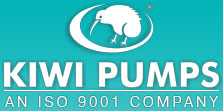
Pumps Information » Chemical Pumps
Chemical Pumps
Chemical Pumps are more durable than conventional pumps and move fluids in a variety of ways. There are three basic types of chemical pumps: centrifugal, metering, and positive displacement. Centrifugal pumps apply centrifugal force to generate velocity, use rotating impellers to increase velocity, and push fluids through an outlet valve. Metering pumps draw fluid into a chamber, close the inlet valve, and release fluid through the outlet valve. Positive displacement pumps use rollers, gears, or impellers to move fluid into a fixed cavity so that when liquid exits, the vacuum that is created draws in more fluid. Power sources for chemical pumps include AC or DC voltage, hydraulic or pneumatic systems, gasoline or diesel engines, and steam, water, and natural gas. With centrifugal pumps, the velocity of the liquid being pumped is converted into pressure.
These chemical pumps are used to move fluids with a water-like viscosity, or when flow quantities are large in comparison to pressure requirements. Metering pumps are used to pump a wider range of chemicals and feature a high level of repetitive accuracy. Capacity can be adjusted either manually or automatically. Like positive displacement pumps, metering pumps can use a variety of power sources and rollers, gears, or impellers to move fluids. Diaphragm pumps are common industrial pumps that use positive displacement to move liquids. Typically, these chemical pumps include a single diaphragm and chamber, as well as suction and discharge check valves to prevent backflow. Pistons are either coupled to the diaphragm, or used to force hydraulic oil to drive the diaphragm. Double diaphragm pumps are often part of fluid transfer systems where operators use switches or valves to control media flow continuously or on demand.
With double diaphragm pumps, two diaphragms are mechanically, hydraulically, or pneumatically oscillated to displace liquid. One chamber contains the actuator or power source, and the other contains the fluid media. Chemical pumps vary according to maximum discharge pressure, inlet size, discharge size, and media temperature. Gear pumps can transport high volume and pressure flows while dosing pumps can move low volumes of liquids at controllable discharge rates. Drum pumps are designed to transport or dispense the contents of drums, pails, or tanks. Injection pumps inject fluid into production systems. Ejector pumps move wastewater that cannot flow to its destination by means of gravity at a velocity of at least 2 feet per second. Motor-driven ejector pumps are often immersible and use a short shaft to connect the motor to the pump housing.
Chemical pumps are used in a wide variety of industries and applications. Some devices are used in power generation, oil and gas production, flood control, and mining. Others have automotive, food processing, or machine tool applications. Chemical pumps are also used in the pulp and paper industry, and in the manufacture of semiconductors. Cryogenic chemical pumps are rated for extremely cold temperatures. HVAC chemical pumps are used in heating, venting, and air conditioning.
